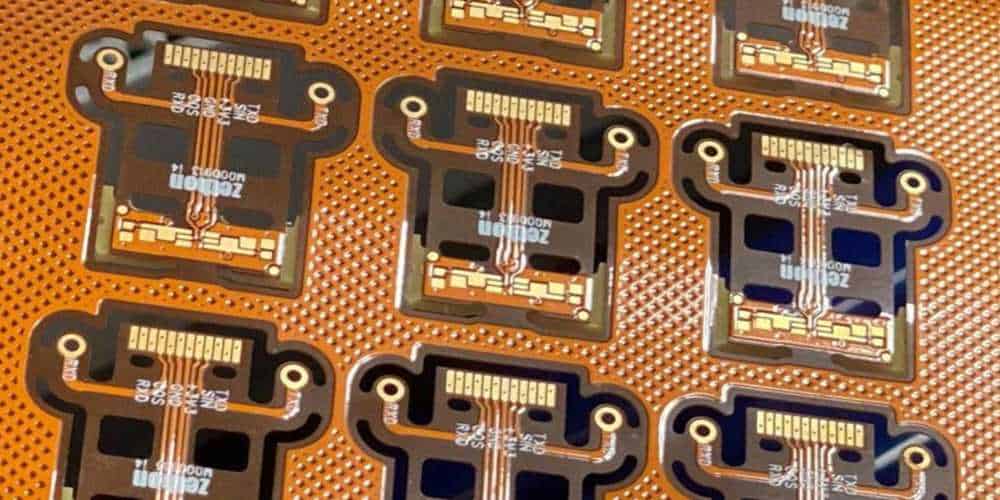Single or Double layer flex PCBs offers severe limitations when it comes to extra power and speed requirement. You cannot use these boards in bigger and complicated projects. In such scenario 4 Layer Flex PCB serve as a key solution. 4 Layer printed circuit boards offer number of advantages in comparison to single layer pricnted circuit boards or double layer printed circuit boards.
It is important to understand 4 layer Flex PCB materials, designing considerations, applications, benefits, and layout to prevent costly mistakes in the future. The aim of this article is to provide in detail and useful insight on each aspect of 4 layer rigid flex PCB. Sounds exciting? Let’s dive in!
How Would You Define 4 Layer Flex PCB?

4 Layer flexible printed circuit boards comprises of 4 conductive layers usually of ployimide rather than FR4. These rigid flex PCBs have top layer, GND, VCC, and bottom layer. You can combine the layers of rigid printed circuit boards through buried or through holes.
Stack up/ Layout of 4 Layer Flex PCB
The manufacturing process of flexible printed circuit boards consists of two inner layers. They have sandwhich like appearance between two outer layers. Copper layer is usually a top layer. A copper layer in flexible printed circuit boards also refer to the signal layer. Bottom layer is also a copper layer.
While placing the components of 4 Layer flex PCB you must consider the spaing in directions of X, Y, and Z. This difference set 4 layer flex PCB apart from rigid flex PCB. Options exist to utilize three dimensional flexible printed circuit board designing tools to prevent bending in the final layout. This will help you achieve better 4 layer flex PCB layout.
Materials Used in Making 4 Layer Flex PCB
The materials are what which make your 4 Layer Flex PCB stand out and results in effective longevity. Materials enable your 4 layer flex PCB to cope up with usage demands. Materials that you can use in your 4 Layer Flex PCB have 3 different categories.
- Base Material
In flexible circuit boards base material refers to the material which act as a foundation. In rigis flex PCBs it is a flexible polymer film. On the other hand polyimide film refers to the substrate. Polyimide is very flexible and can bear high temperature applications. The polyimide imparts all characteristics that your rigid flex PCB needs. Polyimide reduces the board thickness of your rigid flex pcb. Becuase of flexibility in polyimide slight bend prevent breakage such as in hard boards. Another characteristic of polyimide is that it does not need adhesive to copper attachement.
- Adhesive
The role of adhesive is to form a bond. In case if the base material is polyimide in rigid flex PCBs, then adhesive serve its role in limiting the performance of laminate. Several issues come along with when you make use of polyimide adhesives. Adhesive of alternative polymer families serve thier purpose in this regard. In flex circuits adhesives have varying thicknesses. The kind of application determines the adhesive thickness in flex circuits.
- Conductive Material
The conductive material is what make layer flex PCB suitable in industrial control equipment or industrial applications. In layer flex PCB the conductive material is Copper. The incredible electrical properties, copper thickness, and affordability are what make it desireable for layer flex circuit board. Copper foil has two main types, electrodeposited and rolled/ wrought. Beside these foils the foils with less copper thickness also in demand these days.
Why Invest In 4 Layer Flex PCBs?
There are several benefits you can enjoy after investing in flexible circuit board. Some of the key benefits are as follows
- You can use these flexible circuit board with any component or connector you want. The compatibility of these flexible circuit boards is very vast.
- The reliability and stability of this flexible circuit board technology is far more than rigid layer flex PCBs. The main reason behind this is flexible circuit board possess few sloder joints or interconnects. This reduce the instance of errors that may occur.
- The weight of flex circuits is very low. You can easily transport them anywhere you want. They utilize very less space in rigid flex pcbs becuase of their compact size. This is suitable in industrial control equipment. This makes rigis flex PCBs installation a lot easier and manageable.
- You get higher circuit density when you choose 4 layer rigid flex PCBs. The high cricuit density can cope up several requirement in rigid flex PCBs.
- The printed circuit board comprises of highly thermally stable material. This is truly beneficial in electronics industry/ consumer electronics where you need to fulfill higher current requirements.
- The lightweight and dimensional stability in flex boards technology is remarkable. It features unmatchable signal quality, sufficient control on impedance, and versatile operation give it edge over its competitors.
Applications of 4 Layer Flex PCB

This deivce act as a center operational component for multiple devices in the market. You cannot ignore the importance of this thin and lightweight device in industrial applications in terms of power and performance. Some of the key applications include:
- Less overall weight and low bend radius makes these flex PCBs suitable for medical devices and industrial control equipment. In automotive industrial applications the layer flex pcbs have effective use in vehicle interior controlling equipments, ABS system, dashboard etc.
- Flex boards components serve as one stop service for consumer electronics industry. For example in calculator, motion monitors, camera, keyboard, tablet etc.
- In medical indsutry you can use these flex pcbs for interconnection with resistors, circuits, and capcitors.
- Remarkable power, stiffener and thin capabilities of flex PCBs on the industry makes them a perfect fit. For instance majorly in aeronautical and marine equipments.
- In the phone market layer flex pcb act as center and is popular choice. Its assembly and green color on one side or either sides soothes eyes. In compact device like cell phone, it serves as to cope up multiple interconnections. It add up to your cellphone efficiency.
Verdict
If you are looking for a main /center PCB manufacturer in China, then you have come to the right place. China PCB manufacturers offer low cost, short lead-time, high quality. They are open to custom PCB requirements. PCB companies in China manufacture state of the art PCB components. We love to provide you in detail information on any aspect for which you are curious. Call China manufacturers today to get your quote.

